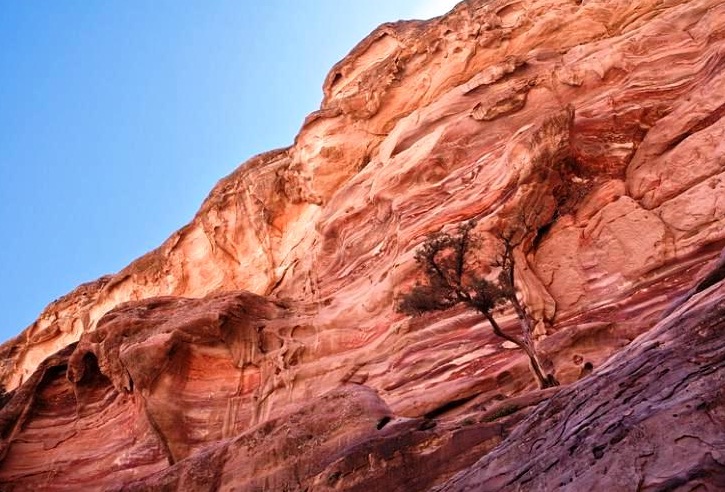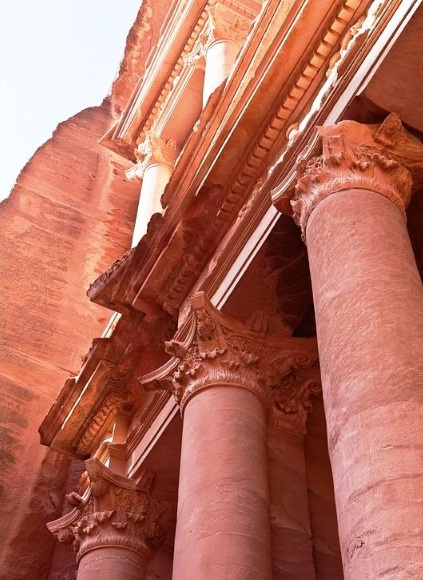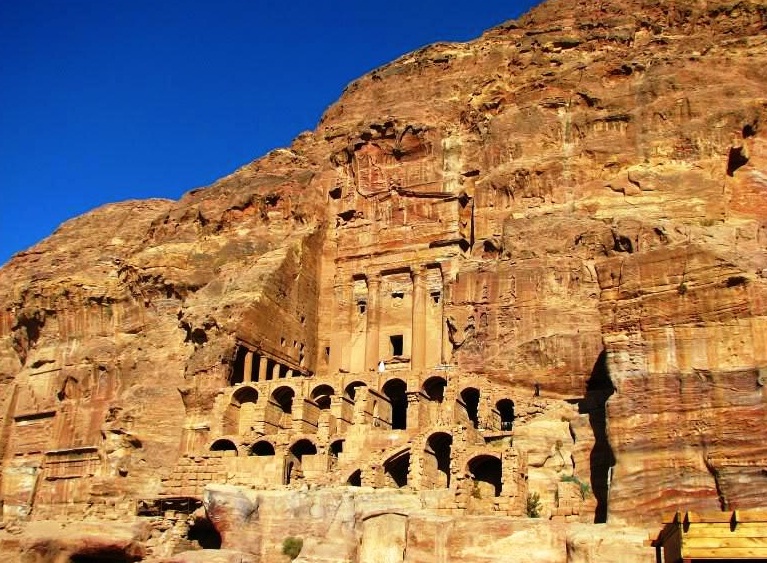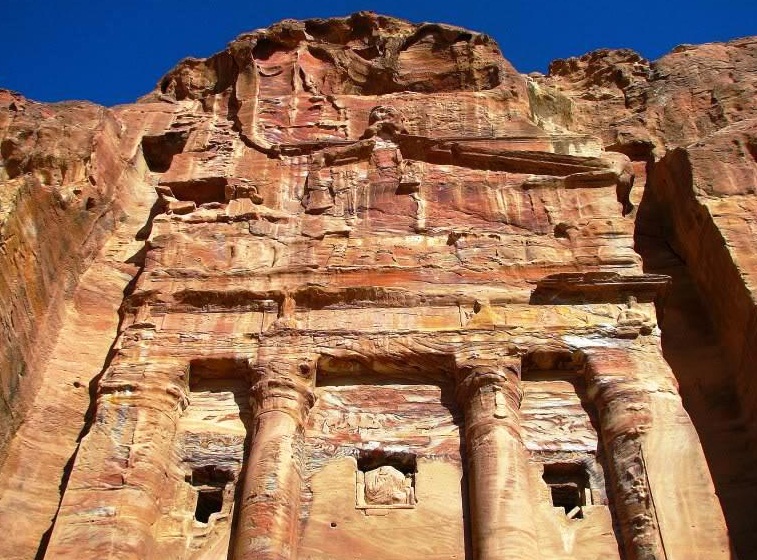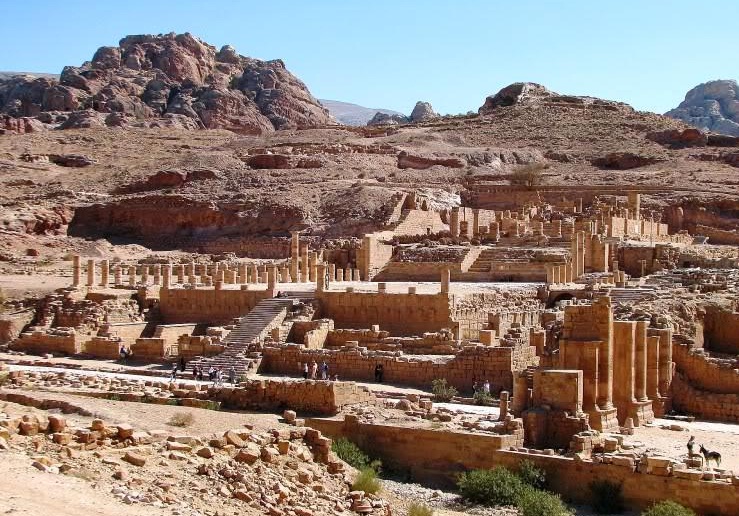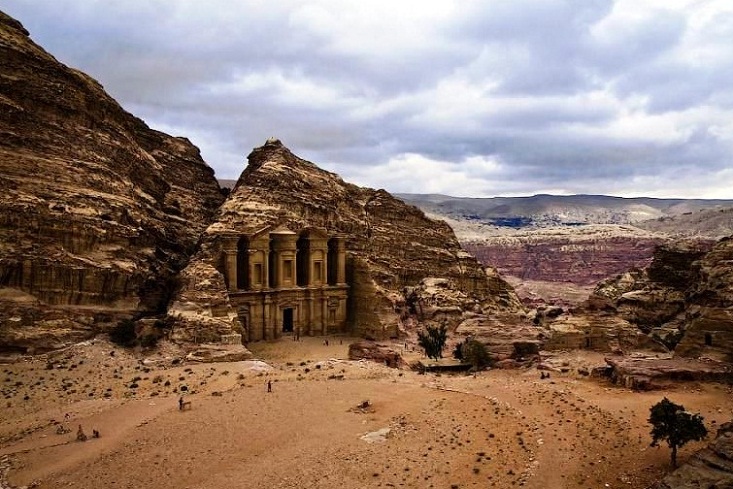Destinations / Top cultural destinations in Asia / Petra in Jordan
Petra in Jordan
Castles lost in the desert, cities carved in stone and lunar landscapes. These are some of the tourist destinations in Jordan that have attracted over six million visitors over the past years. Petra, the ancient capital of the kingdom of Nabataeans, Semitic people of Arabia, became a symbol for this Arab state situated in the Middle East. Unlike other tourist areas in the world, Petra stands out with its special history, depicted by the rock cut facades in reddish-orange colour. The city is also called the "Red City" due to its spectacular structures carved directly in stone, which are colored at sunset in different shades.
The city of Petra is located in southeastern Jordan, to the east from the border with Israel, 262 km south from the capital city, Amman, in the proximity to the Jordanian town of Wadi Musa. "Stone city" stretches along the foot of Mount Hor and is located in a large valley. Petra can be accessed through a narrow gorge called the Siq ("the shaft"), which is only 3-4 m wide in some places, while being surrounded by hundred-meter rocks. The spledidul gorge is colored in eleven natural shades.
During ancient times, the city of Petra was called Rekem, as this name is mentioned in the ancient manuscripts from the Dead Sea. The modern name - "Petra" - comes from Greek, which means "stone" in translation. According to Arab popular belief, the city of Petra is the place where Moses hit the rock with his rod and water came out for the thirsty people during his journey in the desert. The city has been "forgotten" for 1000 years and rediscovered in 1812. It is assumed that the city has been built in the sixth century BC by Nabataeans people. Nabataeans have created one of the greatest ancient civilizations in the Middle East, with its own alphabet, on the basis of which the conventional Arabic alphabet was formed. The territory ruled by them, bounded to the north by the Dead Sea and to south by the Red Sea, was an extension of the great Arabian desert to the north. The Kingdom in the Nabataeans has established its capital in the "Red City", Petra. It was the capital city until 106 AD, when it was absorbed by the Roman Empire, becaming the provincial capital, Arabia Petraea. The city continued to flourish in the next century, then registered a decline and was finally abandoned, being destroyed by an earthquake in 363. The earthquake destroyed most of the buildings as well as the water supply system. The first European to discover this place was Johann Ludwig Burckhardt in 1812. The explorer's discovery was described in a sonnet by John William Burgon as "a red-rose city half as old as time." Bedouins, people of the desert, were those who lived in these settlements carved in rock by the end of the twentieth century, when tourism started to grow here, somewhat disturbing the silence of this ancient city. Also, it is worth mentioning that the popularity of the ancient city of Petra has increased after the Indiana Jones movie was shot here.
The architecture of the spectacular edifices of Petra, carved in red rock feature two influences: Nabataean and Greek-Roman, yet their architecture has been influenced over time by North-Syrian and Egyptian styles. One of the distinctive elements of the Nabataean period is the cylindrical crypt, while during the reign of the Ptolemaic dinasty Petra acquired the aspect of a Hellenistic city. Flanked by massive stone walls and supplied with water from a river which crosses the place periodically, the city of Petra is not only a natural and safe fortress, but it is strategically positioned at the crossroads of important trade routes. Thus, the city was crossed by trade routes that went to Gaza in the west, to Bosra and Damascus in the north, to Aqaba and Leuce Come on the Red Sea and toward the Persian Gulf over the desert. Excavations in the area have shown that Nabataeans managed to build a city in the desert due to their ability and ingenuity to control water reserves by creating an artificial oasis.
Entrance to Petra is made through the Siq gorge. The curve and smooth lines of the walls are the work of wind, which has shaped the rock. Sometimes the narrow passage is less than 5 meters wide and has a length of 1.2 km. Here, the water conduits through which the Nabataeans used to bring water in the heart of the city still exist today. Although in the past the Siq was paved with stone, today it is covered by a layer of fine sand. Hence, in order to get to the ancient city of Petra, you must first walk through the valley of Bab as-Siq. In order to cross this valley, a good stamina is required, because you will need to walk. If you are not delighted by this idea, then you can rent a donkey or two-wheeled carts drawn by horses, right at the entrance of Bab as-Siq Valley. While crossing this valley, you will have the chance to admire the stone carvings made by Nabataeans, called "jinn blocks" which are believed to be representations of deities.
The main attraction of Petra is the temple popularly called "the Treasury", Al Khazneh. This is the place where valuables were kept. This temple impresses with its spectacular facade cut in rock, 40 meters high and very well preserved, whose carving took 40 years. Some experts have dated the construction from the first century BC. Due to the fact that it houses the royal tombs and as a result of the numerous legends about pirates hidding their treasures here, the edifice was called "the Treasure". Al Khazneh was appointed by the New Open World Corporation as one of "the seven new wonders of the world."
Similar in appearance, yet larger in size, is the El-Deir Monastery, which can be reached after climbing 750 steps. It takes about half an hour to climb on foot or on a donkey to get there. The monastery – one of the most important monuments in Petra - dates from the first century BC. It was dedicated to King Obodas I and it is believed to be the symposium of "Obodas god." This information is inscribed on one of the ruins of the monastery - in Arabic, this monument is called "Ad-Deir". The monastery is located in the northwesternmost point of the Petra valley, hidden away on the street with columns. The monastery is the monument with the largest façade in the entire valley of Petra, with a width of 50 meters and a height of 45 meters. The door of the monument itself is 26 meters tall. Despite its name, the monument was carved in stone as a tomb, yet the crosses cut in the interior have led to the current name of the place.
The main street is paved with stone and surrounded by columns. Here you can admire the amphitheater, square and public fountain. The amphitheater has been cut in the hillside and some of the graves during its construction. Inside, traces of the graves are still visible- rectangular scattered pits. On the edges there have been built observation towers also carved in stone. At the end of the street, the entrance to the Temple of Dushara (deity of Nabataeans), best known as the "Temple of Pharaoh's daughter" is located. This temple is built of massive blocks of yellow stone and has been restored for several times. In the complex of Petra, you can also visit other places such as different graves, houses of Nabataeans, sacrifice plateau "High Place of Sacrifice", etc.
The city of Petra is considered one of the seven new wonders of the world, and in 1985 was included in UNESCO World Heritage, Petra complex being described as "one of the most precious cultural heritage of mankind".
Others Top cultural destinations in Asia .
Maps of Petra in Jordan
map JordanOthers from Top cultural destinations in Asia
Check out our selection of the best cultural destinations in Asia to discover and explore the beautiful Asia and its culture!











